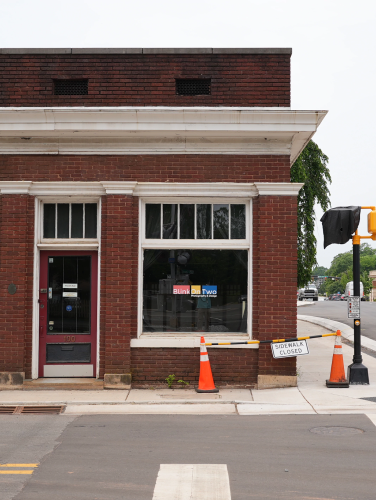
Bank of Huntersville
(ca. late 1800s)
The nineteenth-century Bank of Huntersville once anchored the town’s first commercial center.
100 Main St., Huntersville, NC 28078
Like other small towns in Mecklenburg County, Huntersville was a railroad town. It grew as a function of the Atlantic, Tennessee & Ohio Railroad (later the Norfolk Southern Railroad) whose tracks run parallel to Main Street. The A.T.&O. tracks provided the impetus for the town’s development and subsequent chartering in 1873. Originally called Craighead – in honor of the influential Reverend Alexander Craighead of Charlotte’s Sugaw Creek Presbyterian Church, the first pastor of the first church of any kind in Mecklenburg County – the town was renamed for Robert Boston Hunter, a member of the locally prominent Hunter family. The presence of the railroad encouraged additional development within the town, including the 1878 establishment of Huntersville High School Academy, one of the first two high schools in western North Carolina, and the 1898 opening of a cotton spinning plant by Anchor Mills.
Property Quick Links
As with other rural Mecklenburg County communities, a small row of commercial buildings grew up along Huntersville’s railroad tracks during the late nineteenth century. Its development along the railroad connected the town to distant markets, making the town an important commercial center for area farmers and the distribution center for the area’s cotton crop. This commercial row, situated primarily on one side of one block to the west of the railroad tracks, provided the arrival point for train travelers to Huntersville.
Like many other early banks in small southern towns that were intentionally positioned at important intersections to draw customers, the building on the corner of Main Street and Gilead Road (100 Main Street) originally housed the North Mecklenburg Bank. A progression of banks operated at that location over the years, including the Bank of Huntersville, the Bank of Cornelius, and First Union National Bank. Immediately south of the bank, the building at 102 Main Street once housed Smith's Grocery Store. It was purchased in 1944 by B. H. and Glenna Smith. The next building, 104 Main Street, was once Mullen's Drug Store. According to the deed acquired by Allen Porter Mullen in 1947, the land now comprising 104 Main Street was vacant when he bought it. Earlier deeds for that property note that the lot was originally two parcels, one known as the Post Office building lot and the second contained some unspecified 1907 structure that the new owner was restricted from demolishing it until 1908. The fourth and final building in this row, 106 Main Street, was once J. R. McCurdy's dry goods store. Prior deeds for that property indicate that a store owned by John and James Woodsides operated on that site as early as 1887.
Longtime residents of Huntersville recall that "downtown" once occupied three blocks of Main Street and included a meat market, Cross's General Store (later the Ranson Brothers Grocery), J. R. McCurdy's Dry Goods, Sam Holbrook's Grocery Store, Mullen's Drug Store, and a barber shop. Now the brick commercial row sits as an adjunct part of Huntersville. Main Street began to lose its vitality in the 1920s as automobiles became more popular and affordable to the public. The town’s commercial activity shifted to the west, first along NC 115 (Old Statesville Road) and later along the I-77 corridor. When viewed together, the four buildings located at 100, 102, 104, and 106 Main Street stand as the last remnant of historic fabric that comprised Huntersville's once-thriving commercial district.

